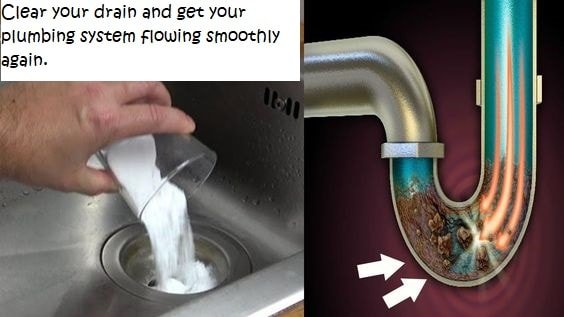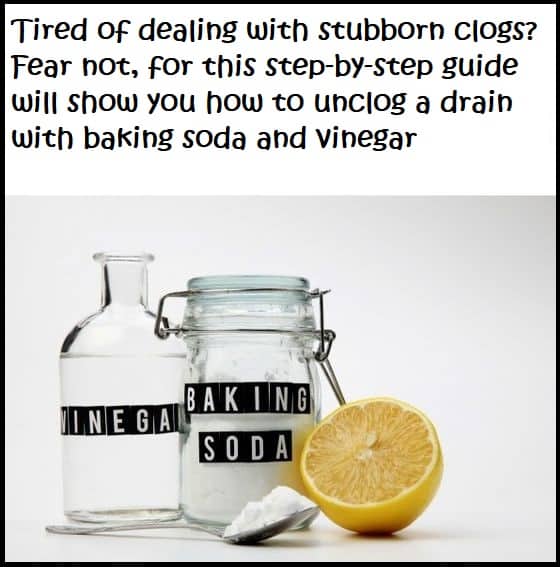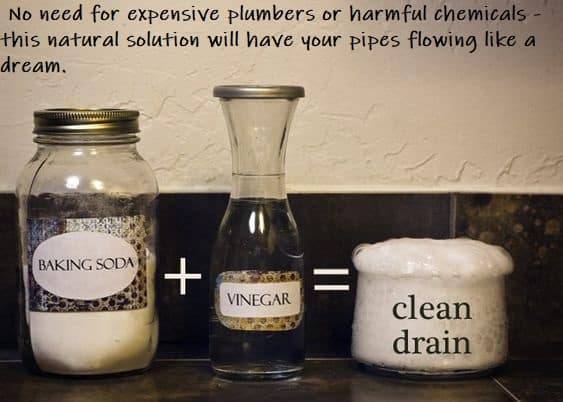Tired of dealing with stubborn clogs? Fear not. This step-by-step guide will show you how to unclog a drain with baking soda and vinegar.
Say goodbye to harsh chemicals and hello to a natural, effective solution for a clogged drain. Follow these simple instructions and get your plumbing system flowing smoothly again.
Using baking soda and vinegar to unclog a drain is a safe, affordable, and effective method used for generations.
Not only is it gentle on your plumbing, but it’s also better for the environment than chemical drain cleaners.
Baking soda and vinegar are natural cleaning agents often used in eco-friendly cleaning products.
Unclogging a drain with baking soda and vinegar is simple and requires only a few common household items.
All you need is baking soda, vinegar, boiling water, and a little bit of patience. You can clear even the toughest clogs in your drains by following a few easy steps.
We’ll cover everything from preparing supplies to flushing your drain with boiling water.
Whether you’re a DIY enthusiast or just looking to save money, using baking soda and vinegar to unclog your drain is a simple and effective solution you won’t want to miss.
So, if you’re ready to tackle that clogged drain, read on and discover how to unclog a drain with baking soda and vinegar!
Read More on How To Clean An Oven With Baking Soda And Vinegar
How to Unclog a Drain With Baking Soda and Vinegar
Have you ever experienced a clogged drain? It can be frustrating, especially if it results in standing water in your sink or bathtub.
Fortunately, you can take a few simple steps to unclog your drain using only baking soda and vinegar.
This article will walk you through the process, so you can quickly and easily fix your clogged drain.

Step 1: Gather Your Materials
Before starting the process, you must have all the necessary materials.
These include:-
- Baking soda
- Vinegar
- Boiling water
- Measuring cup
- A funnel.
It’s important to have everything ready beforehand to work efficiently and effectively.
Step 2: Boil Water
Boiling water is an essential part of the process as it helps to loosen any grease, hair, or other materials clogging the drain.
Bring a pot of water to a rolling boil and remove it from the heat. Be careful when handling boiling water, as it can cause burns.
Step 3: Measure and Pour Baking Soda
Measure 1/2 cup of baking soda and pour it down the clogged drain.
Baking soda is an alkaline compound that reacts with vinegar to create a chemical reaction that can break down stubborn clogs.
It also helps to neutralize odors caused by the blockage.
Step 4: Add Vinegar
Next, pour 1 cup of vinegar down the drain on the baking soda.
The vinegar is an acid that reacts with the baking soda to create a fizzy reaction that can help break up the clog.
You may want to use a funnel to get all the vinegar into the drain.
Step 5: Wait and Rinse
Once you’ve added the vinegar, let the mixture sit for 15-30 minutes.
During this time, the fizzing action will help to break up any clogs in the drain.
After waiting, boil another pot of water and carefully pour it down the drain to flush away any remaining debris.
Step 6: Repeat if Necessary
If the clog is still present after the first round of baking soda and vinegar, you may need to repeat the process a few more times.
For tougher clogs, you may also need to use a plunger or a drain snake to help remove the blockage.
Benefits Of Using Baking Soda & Vinegar As A Drain Cleaner
- Safe for the Environment: Unlike chemical drain cleaners, which contain harsh and toxic ingredients that can harm the environment, baking soda and vinegar are natural and eco-friendly. They do not release harmful chemicals into the environment and can be safely disposed of down the drain.
- Cost-effective: Baking soda and vinegar are readily available at most grocery stores and are much cheaper than chemical drain cleaners. This makes them a cost-effective solution for cleaning drains.
- Safe for Pipes: Chemical drain cleaners can be harsh on pipes and can cause damage over time. On the other hand, baking soda and vinegar are gentle and safe for most types of pipes. They can help to remove clogs without causing any damage.
- Effective Removing Clogs: The chemical reaction of baking soda and vinegar combined creates a fizzing action that helps break down clogs. This makes them an effective solution for removing most types of clogs in drains, including those caused by grease, hair, and soap scum.
- Versatile: Baking soda and vinegar can clean other home areas, including kitchen surfaces, bathrooms, and laundry rooms. This makes them a versatile and multi-purpose cleaning solution.
- Easy to Use: Using baking soda and vinegar to clean drains is straightforward. It requires no special equipment or expertise and can be done in just a few minutes.
Read More How To Clean Shower Head Without Vinegar
How to Unclog a Drain with Baking Soda and Apple Cider Vinegar
A clogged drain can be frustrating and inconvenient for many homeowners.
While there are various methods to unclog a drain, one of the most effective and affordable solutions involves baking soda and apple cider vinegar.
This article will discuss the step-by-step process for unclogging a drain with these simple household items.

Step 1: Boil Water
Before you begin the baking soda and apple cider vinegar treatment, it’s important first to clear any debris or loose material from the drain.
Start by boiling a pot of water on the stove. Once the water has come to a boil, carefully pour it down the drain.
The hot water will help to loosen any blockages and prepare the drain for the baking soda and apple cider vinegar treatment.
Step 2: Pour Baking Soda into the Drain
The next step is to pour one cup of baking soda down the drain.
Baking soda is a natural cleaning agent that effectively breaks down stubborn clogs.
It also has the added benefit of neutralizing any unpleasant odors that may be coming from the drain.
Step 3: Add Apple Cider Vinegar
After pouring the baking soda down the drain, the next step is to add one cup of apple cider vinegar.
The reaction between the baking soda and vinegar will cause a fizzing reaction that will help to break up any remaining debris and clear the clog.
Step 4: Cover the Drain
Once the baking soda and apple cider vinegar have been added, cover the drain with a plug or stopper.
This will prevent any of the fizzing mixtures from escaping and allow it to work its magic in the drain.
Step 5: Wait and Rinse
Let the mixture sit in the drain for at least 30 minutes.
During this time, the fizzing reaction will help to break down the clog and clear the drain.
After 30 minutes, remove the cover and flush the drain with hot water.
This will help clear away any remaining debris and ensure the drain is fully unclogged.
Tips and Tricks
For particularly stubborn clogs, you may need to repeat the baking soda and apple cider vinegar treatment multiple times.
If you don’t have apple cider vinegar, you can use white vinegar as a substitute.
Additionally, it’s important to maintain your drains properly to prevent future clogs.
This includes regularly cleaning them with baking soda and vinegar and avoiding putting grease, oil, or large food particles down the drain.
How to Clean a Clogged Drain With Salt and Baking Soda
Salt and baking soda are both common household items that you may already have in your pantry. These natural ingredients work together to break down clogs and clean your drain without damaging your pipes.
Step 1: Gather your Supplies
The first step in cleaning a clogged drain with salt and baking soda is to gather your supplies. You’ll need half a cup of baking soda, half a cup of salt, and boiling water.
Step 2: Pour Salt and Baking Soda Down the Drain
Once you have your supplies, pour the baking soda and salt down the drain. Make sure to get as much of the mixture down the drain as possible.
Step 3: Let the Mixture Sit
Allow the baking soda and salt mixture to sit in the drain for at least 30 minutes. During this time, the mixture will break down clogs in your drain.
Step 4: Pour Boiling Water Down the Drain
After the mixture has sat for at least 30 minutes, pour boiling water down the drain. The boiling water will help to flush out any remaining clogs in your drain.
Step 5: Repeat the Process
After the first try, you may need to repeat the process if your drain is still clogged.
Pour another half cup of baking soda and salt mixture down the drain and let it sit for 30 minutes before flushing with boiling water again.
How Often to Clean Your Drains
Regular drain cleaning is important to maintaining a healthy and functional plumbing system.
Over time, drains can become clogged with hair, grease, soap scum, and other debris, leading to slow drainage or complete blockages
However, to prevent these issues, cleaning your drains regularly is important.
How often you should clean your drains depends on a few factors, including the type of drain, the amount of use, and the amount of debris that goes down the drain.
Here are some general guidelines to follow:
Kitchen Drains
The kitchen should be cleaned more frequently than other drains, as they are often exposed to a high volume of grease, food particles, and other debris.
A good rule of thumb is to clean your kitchen drains once a month.
You can use a mixture of baking soda and vinegar to clean your kitchen drains or a commercial drain cleaner specifically designed for kitchen drains.
Bathroom Drains
Bathroom drains, including sinks, showers, and tubs, can also become clogged with hair, soap scum, and other debris.
Depending on the amount of use, these drains should be cleaned every few months.
You can use a mixture of baking soda and vinegar or a commercial drain cleaner specifically designed for bathroom drains to clean your bathroom drains.
You can also use a drain snake to remove any hair, or other debris stuck in the drain.
Other Drains
Other drains in your home, such as laundry room and basement floor drains, may not require regular cleaning unless exposed to a high volume of debris.
If you notice slow drainage or other issues, it may be time to clean these drains.
Generally, inspecting your drains regularly and cleaning them as needed is a good idea.
By doing so, you can prevent clogs and keep your plumbing system functioning smoothly.
If you’re uncomfortable cleaning your drains, consider hiring a professional plumber to do the job.
Wrap Up On How To Unclog A Drain With Baking Soda And Vinegar
Well, folks, we’ve ended our unclogging journey together. We hope that you’ve learned something new and exciting about the wonderful world of baking soda and vinegar.
Who knew these two everyday items could be so powerful and effective in tackling stubborn clogs?
Now that you’re armed with the knowledge of how to unclog a drain with baking soda and vinegar, you can be the hero of your household.
You’ll no longer have to suffer through the frustration of a slow-draining sink or the embarrassment of a toilet that won’t flush.
You’ll be able to tackle those clogs like a pro!
And let’s not forget about the environmental benefits of using natural cleaners like baking soda and vinegar.
You’re not only saving yourself money, but you’re also doing your part to help protect our planet. Mother Nature thanks you!
So, go forth and tackle those clogs with confidence, knowing that you have the power of baking soda and vinegar on your side.
And who knows, maybe you’ll even inspire your friends and family to join the natural cleaning revolution. Happy cleaning!
